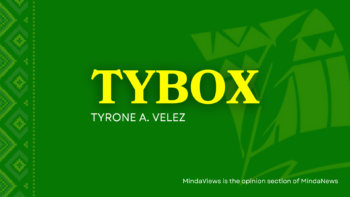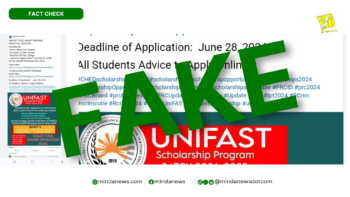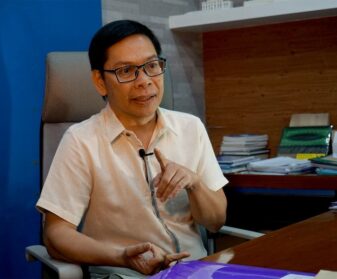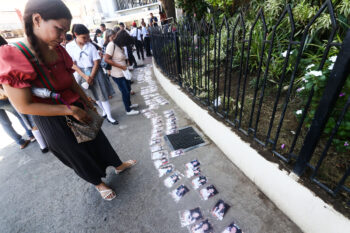GENERAL SANTOS CITY (MindaNews/15 December) — With the impeachment of Supreme Court Chief Justice Renato Corona, President Benigno Simeon C. Aquino III is crossing his Rubicon. It now all depends on the Senate as impeachment court if the President will cross his Rubicon triumphantly or will sink midstream.
The House of Representatives transmitted the Articles of Impeachment to the Senate last Tuesday, December 13, and immediately formed a team to prosecute Corona. The Senate constituted itself into an impeachment court and was to issue summons to Corona after the senators had taken their oath as judges. Corona has ten days to answer the charges.
With the impeachment trial rules already ready, the trial can start on January 16, 2012. Unless Corona resigns, the trial is estimated to take about six months. A guilty vote by at least 16 senator-judges (two-thirds of the full Senate membership) on just one of the eight impeachment articles will convict Corona.
The Liberal Party Representatives in the House and their allies initiated the impeachment to support President Aquino’s crusade against crime and corruption. Aquino had publicly accused the Corona Court of obstructing the campaign. The House cited in the Articles of Impeachment the pattern of obstruction and other alleged impeachable acts of Corona.
Aquino’s crusade is his dilemma. The credibility of his presidency depends on the fulfillment of his crusade which necessarily demands the prosecution of his immediate predecessor, President Gloria Macapagal-Arroyo and public officials out of office and still in office considered her allies in her perceived reign of corruption. However, within a year and a half of his presidency, Aquino and his allies see the Corona Court – in the name of constitutional rights – as blocking his crusade.
The crusade now imperatively includes the dismantling of the blockade. Aquino and his allies believe they have to cross the Rubicon – the point of no return. The Corona Court has to be tackled by the horn. Failing to convict Corona, the Aquino presidency will lose its credibility; but by not removing the blockade, the crusade will fail making the Aquino presidency lose not only credibility but also relevance. Their only option is to cross their Rubicon.
[NOTE: “Crossing the Rubicon” is a metaphor for deliberately proceeding past a point of no return. The phrase originates with Julius Caesar‘s seizure of power in the Roman Republic in 49 BC. Roman generals were strictly forbidden to bring their troops into the home territory of the Republic in Italy. On 10 January, Caesar led his army across the Rubicon River, crossing from the province of Gaul into Italy. After this, if he did not triumph, he would be executed. Therefore the term “the Rubicon” is used as a synonym to the “point of no return”.]
In his last three speeches, December 1, 5 and 13, Aquino must have seen how criticizing Corona and his Court polarized political and social forces into his allies and critics. The impeachment has already widened and deepened the polarization. Ranged against Aquino and his allies are the Arroyo-Corona partisans and the advocates of constitutionalism and the doctrine of separation of the three independent branches of republican government.
The House swiftly produced the articles of impeachment and 188 signatures to endorse them in order to by-pass the usual House justice committee and plenary deliberations. This prevented the opposition from getting a restraining order from the Supreme Court. By this swiftness, Aquino is now being pictured as an emerging autocrat and dictator, even if this is allowed under Article XI, Section 3(4) of the 1987 Constitution.
Aquino and his House allies have on their side the majority of the Filipinos who elected Aquino on the promise to cleanse the government of corruption. Poll surveys show the people’s continuing support of Aquino – interpreted as support of his crusade. Countering the advocates of constitutional rights and the doctrine of separation are political thinkers and leaders who see how corruption has been nourished through the abuse of these rights and doctrine.
How the polarization will affect the impeachment trial of Corona will be seen in the first six months of 2012.
The historic peaceful EDSA people power revolt should have cured the country of the cancer of corruption that for decades grew in Philippine governments and reached its critical stage during the Marcos dictatorship. But lying dormant it stirred back to life even during the presidency of Aquino, the Mother. Eventually, it mounted a vengeful come back guilefully protected under constitutional rights.
History is on the side of Aquino, his House allies and the majority nationwide supporting Aquino. Arroyo is perceived to have resurrected Marcos. Aquino, the Son, promised during his election campaign to do what his Mother President and other presidents after her had failed to do: Rid the country of corruption. In his election he has the mandate.
The Roman conqueror Julius Caesar crossed the Rubicon, defying what the law of the Roman Republic forbade. The Romans triumphantly received him. However, the Roman senators, led by Caesar’s bosom friend Brutus, fearing Caesar would crown himself Emperor, invited him to the Senate and there assassinated him to preserve the Republic.
The articles of impeachment detail how the President and the House majority see Corona and his Court as obstacles to the administration’s crusade against corruption – charges that Aquino had repeatedly said in his recent speeches before the Makati Business Club, December 1; at the First National Criminal Justice Summit, December 5; and at the Administration Coalition Caucus, December 13.
In his speech at the Supreme Court before court officials, employees and supporters yesterday afternoon, December 14, Corona denied one by one the charges against him. As defender of true justice, the nobility of the Supreme Court and the freedom of the Judiciary, he will face the impeachment trial which “is not only an attack on my person but also an attack against the high court as an institution and the judiciary”. He said he “is opposing the slowly forming dictatorship of President Benigno Simeon Aquino III”.
The senators will judge Corona not only on the basis of the eight articles of impeachment. Besides their political biases, the polarization around constitutionalism and doctrine of separation will weigh on their judgment. They only have two opposing options: Convict Corona to allow Aquino to triumphantly cross his Rubicon; or, acquit Corona to sink Aquino midstream together with his crusade and the fears of his creeping dictatorship.
Figuratively, will the Philippine senators do unto Aquino what the Roman senators did unto Caesar on March 15, 49 BC or 2,060 years ago? – (MindaViews is the opinion section of MindaNews. Patricio P. Diaz writes the column, “Comment”. You may e-mail him at patpdiazgsc@yahoo.com.)







